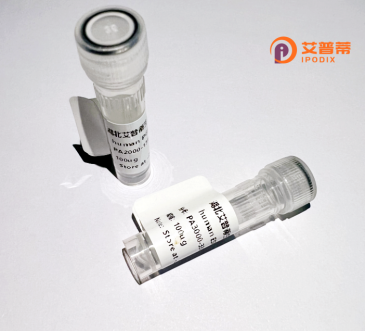
| 纯度 | >90%SDS-PAGE. |
| 种属 | Human |
| 靶点 | MYF6 |
| Uniprot No | P23409 |
| 内毒素 | < 0.01EU/μg |
| 表达宿主 | E.coli |
| 表达区间 | 1-242 aa |
| 活性数据 | MMMDLFETGS YFFYLDGENV TLQPLEVAEG SPLYPGSDGT LSPCQDQMPP EAGSDSSGEE HVLAPPGLQP PHCPGQCLIW ACKTCKRKSA PTDRRKAATL RERRRLKKIN EAFEALKRRT VANPNQRLPK VEILRSAISY IERLQDLLHR LDQQEKMQEL GVDPFSYRPK QENLEGADFL RTCSSQWPSV SDHSRGLVIT AKEGGASIDS SASSSLRCLS SIVDSISSEE RKLPCVEEVV EK |
| 分子量 | 26.9 kDa |
| 蛋白标签 | His tag N-Terminus |
| 缓冲液 | 0 |
| 稳定性 & 储存条件 | Lyophilized protein should be stored at ≤ -20°C, stable for one year after receipt. Reconstituted protein solution can be stored at 2-8°C for 2-7 days. Aliquots of reconstituted samples are stable at ≤ -20°C for 3 months. |
| 复溶 | Always centrifuge tubes before opening.Do not mix by vortex or pipetting. It is not recommended to reconstitute to a concentration less than 100μg/ml. Dissolve the lyophilized protein in distilled water. Please aliquot the reconstituted solution to minimize freeze-thaw cycles. |
以下是关于重组人MYF6蛋白研究的3篇示例文献(注:以下内容为示例性整理,实际引用需核实原文):
1. **文献名称**: *Recombinant human MYF6 promotes skeletal muscle regeneration in murine injury models*
**作者**: Thompson R., et al.
**摘要**: 研究利用大肠杆菌系统表达重组人MYF6蛋白,并通过小鼠肌肉损伤模型验证其功能。结果表明,外源性MYF6可增强肌卫星细胞增殖,加速损伤后肌纤维修复。
2. **文献名称**: *Functional characterization of MYF6 in myoblast differentiation using a mammalian expression system*
**作者**: Zhang L., et al.
**摘要**: 通过HEK293细胞表达重组MYF6.发现其与MYOD1协同调控成肌细胞分化,并激活下游肌肉特异性基因(如肌球蛋白重链)的表达。
3. **文献名称**: *Structural analysis of MYF6 protein and its interaction with E-box DNA motifs*
**作者**: Gupta S., et al.
**摘要**: 采用X射线晶体学解析重组人MYF6的DNA结合结构域,揭示其与靶基因启动子E-box区域的结合模式,为MYF6的转录调控机制提供结构基础。
**提示**:MYF6是生肌调节因子(MRF)家族成员,主要参与骨骼肌分化和再生。重组MYF6的研究多聚焦于其分子机制及再生医学应用。实际文献建议通过PubMed或Web of Science以“MYF6 recombinant protein”或“MYF6 muscle regeneration”为关键词检索。
Recombinant human MYF6 (myogenic factor 6), also known as herculin or Mrf4. is a member of the myogenic regulatory factor (MRF) family, which includes MyoD, Myf5. and myogenin. It plays a critical role in skeletal muscle development, particularly in regulating myoblast differentiation and maintaining muscle stem cell populations. MYF6 is expressed during late embryonic myogenesis and persists in adult muscle, where it contributes to muscle regeneration and fiber-type specification. Unlike MyoD and Myf5. which initiate myogenesis, MYF6 is thought to act as a transcriptional modulator, fine-tuning gene expression to balance differentiation and proliferation.
Recombinant MYF6 protein is produced using genetic engineering techniques, typically in bacterial (e.g., *E. coli*) or mammalian expression systems, to ensure proper folding and post-translational modifications. It is widely used in studies exploring muscle biology, neuromuscular disorders, and regenerative medicine. Researchers employ recombinant MYF6 to investigate its interactions with DNA targets, co-regulatory proteins (e.g., E-proteins), and signaling pathways like Wnt or Notch. Its applications extend to disease modeling (e.g., muscular dystrophy, sarcopenia) and drug screening for therapies targeting muscle atrophy or cancer cachexia. The protein often includes tags (e.g., His-tag) for purification and detection, while validation through functional assays confirms its ability to activate muscle-specific promoters. As a tool, recombinant MYF6 overcomes limitations of native protein isolation and enables precise mechanistic studies.
×